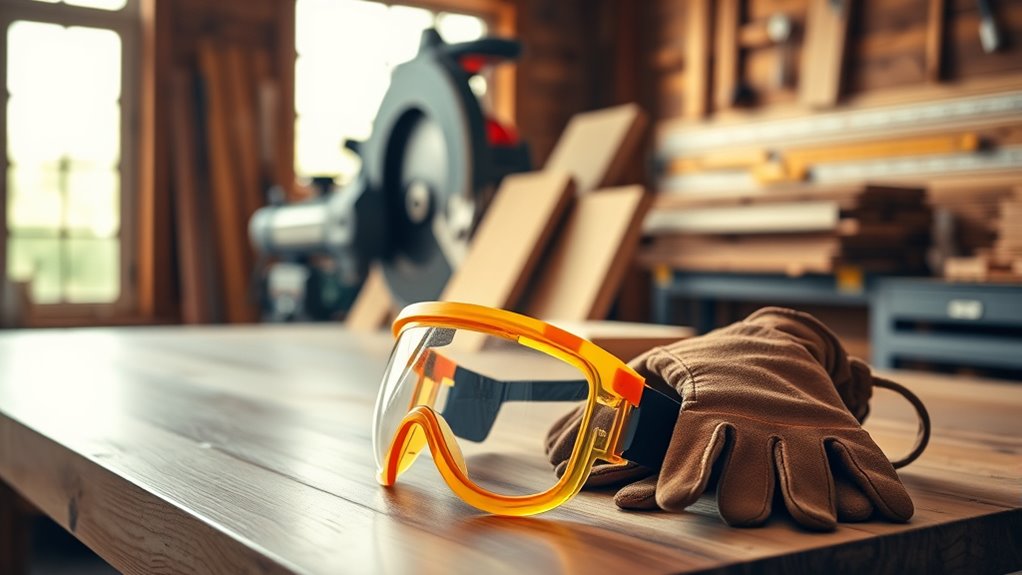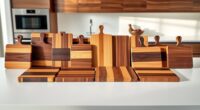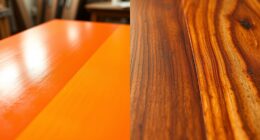To stay safe while woodworking, always use proper blade guards and safety devices to prevent accidental contact. Keep your workspace organized, clean, and free of clutter, and wear appropriate PPE like eye protection, masks, and earplugs. Follow safe operating procedures, inspect and maintain your tools regularly, and manage dust hazards effectively with extraction systems. Use push sticks and featherboards correctly to control the workpiece. If you want to learn more, you’ll find essential safety tips to keep you protected every step of the way.
Key Takeaways
- Always use proper safety guards, safety devices, and personal protective equipment to prevent injuries.
- Maintain and inspect tools regularly, ensuring they are in good working condition before use.
- Implement effective dust control and ventilation systems, and wear respiratory protection when working with dust.
- Follow safe operating procedures, secure workpieces properly, and keep the workspace organized to prevent accidents.
- Prepare for emergencies with clear plans, accessible first aid kits, and regular safety training for all personnel.
Always Use Proper Blade Guards and Safety Devices
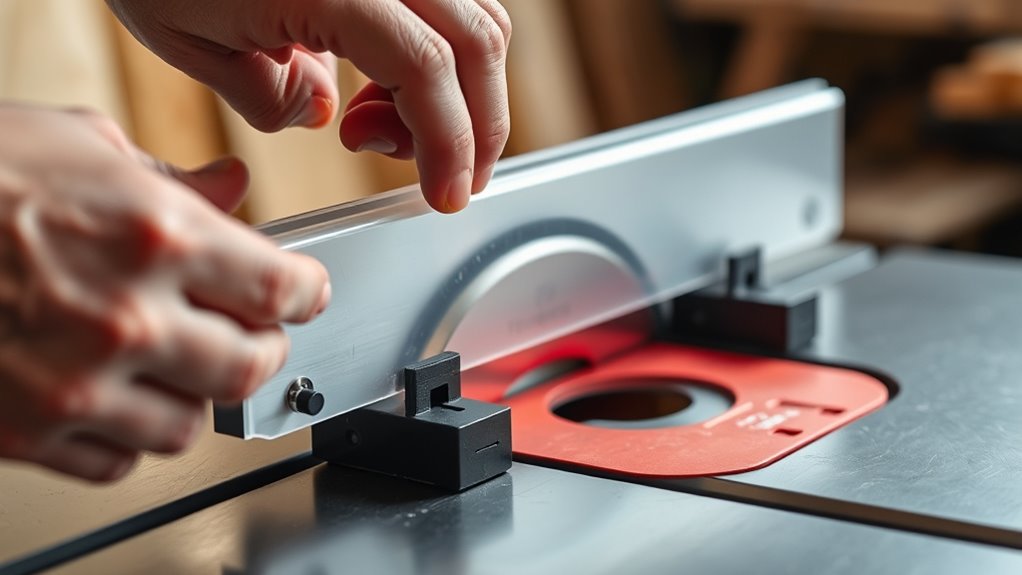
Using proper blade guards and safety devices is essential for preventing injuries while woodworking. These guards shield you from direct contact with spinning blades, drastically reducing the chance of cuts or amputations. They cover exposed blade areas not in contact with your workpiece, helping you avoid accidental touches. Noise levels of modern heat pumps can also impact your comfort and safety during operation, so choosing quieter systems is beneficial. Guards also contain sawdust, splinters, and wood chips, keeping your workspace cleaner and improving visibility. Consistently using guards during cuts is a key safety practice. Many table saws come with factory-installed guards designed for maximum protection and ease of use. Features like clear plastic shields allow you to see your work while staying protected, and components like riving knives and anti-kickback pawls prevent dangerous kickbacks. Proper installation and regular maintenance ensure these safety devices work effectively every time you operate your saw.
Maintain a Clear and Organized Work Environment

Maintaining a clear and organized work environment is essential for safety and efficiency in woodworking. Keep your work surfaces clean and free of clutter to reduce tripping hazards and lower accident risks. Regularly sweep up sawdust and debris, and ensure all surfaces are well-lit for better visibility. Incorporating sound vibrations or calming music into routines can help maintain focus and reduce stress during detailed tasks. Use overhead storage solutions to maximize space and keep floors clear. Designate specific areas for tools and materials to maintain organization. Store tools in accessible, labeled containers or wall-mounted boards to prevent misplacement. Regularly inspect and maintain tools, and secure loose cords to prevent tripping. Arrange your workspace to allow smooth movement around machinery, placing safety equipment within easy reach. Keep walkways obstacle-free, and establish a daily cleanup routine to sustain a safe, efficient environment. Additionally, being aware of industry trends can help you stay updated on the latest safety practices and tools. Staying informed about latest safety equipment can further enhance your workspace safety measures.
Wear Appropriate Personal Protective Equipment
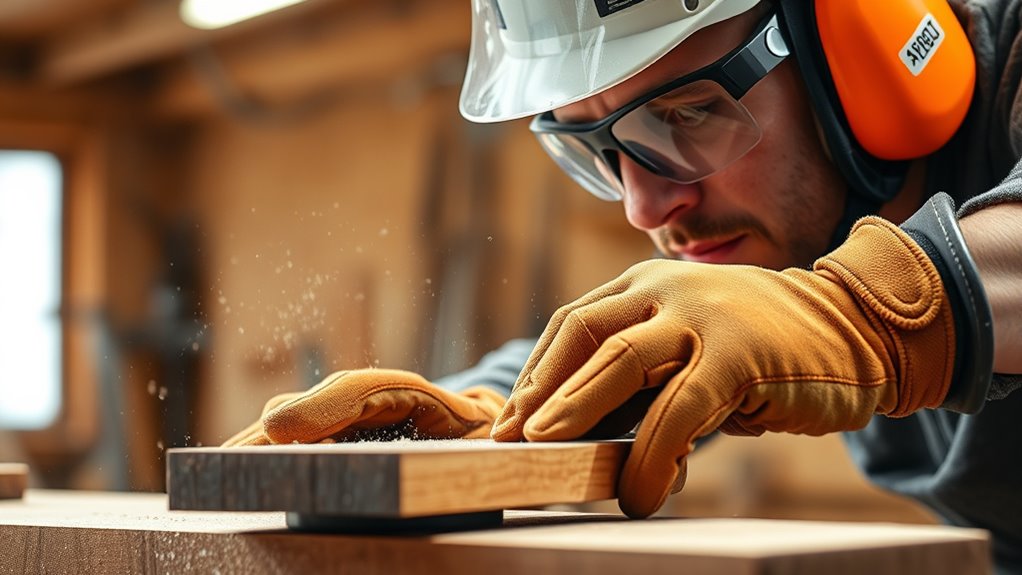
Wearing the right personal protective equipment (PPE) is essential to stay safe while working with wood. Protect your eyes with wrap-around safety goggles that fully cover and prevent wood particles from causing irritation or injury. Remember, prescription glasses don’t offer adequate protection and can shatter on impact.
Face shields provide full face coverage, shielding you from splinters and chips, and should be made of transparent, sturdy materials for visibility and comfort.
Use earplugs or earmuffs to block loud noises from power tools, preventing permanent hearing damage. Best Earplugs for Concerts are designed to reduce volume without compromising sound quality, making them ideal for prolonged use. Additionally, understanding headphone jacks can help you select appropriate audio gear for safety and convenience.
Wear dust masks or respirators rated for wood dust to safeguard your lungs from fine particles. Proper woodworking safety practices and the use of appropriate PPE can significantly reduce the risk of accidents and injuries.
Finally, don’t forget gloves to protect your hands from splinters, cuts, and abrasions, ensuring they fit well for maximum dexterity and safety.
Follow Safe Operating Procedures for Power Tools
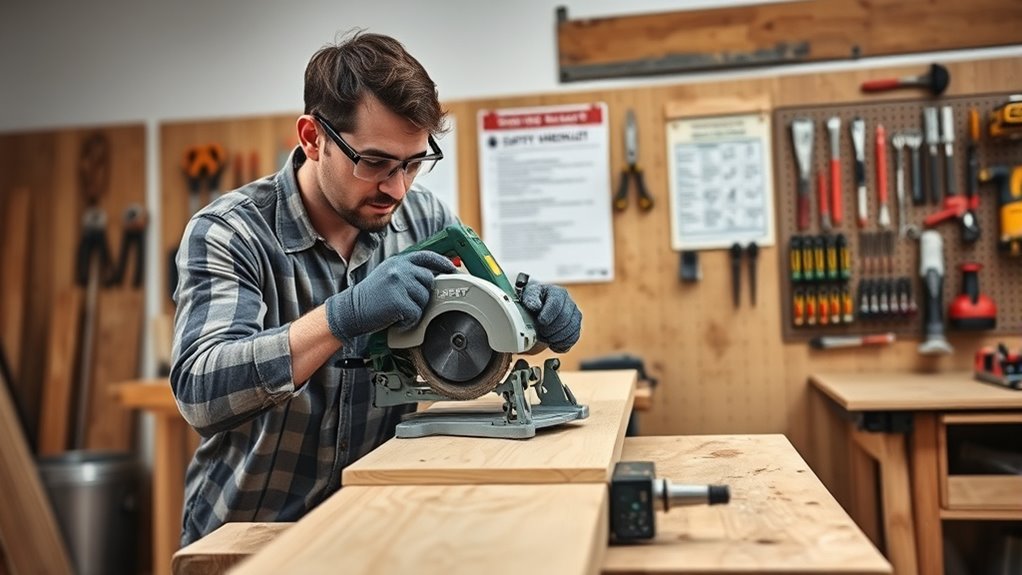
To operate power tools safely, you must follow the manufacturer’s instructions carefully. Read and understand the user manual before using each tool, so you’re aware of hazards and safety precautions. Proper care and maintenance is a key factor to consider when choosing the best options, especially at local spots known for freshness. Use the recommended speeds and settings to prevent accidents and damage. Follow guidelines for maintenance and repairs to keep tools in safe working condition. Only use tools for their intended purposes, respecting their limitations and capacities. Always ensure accessories and attachments are compatible. Prevent accidental starts by turning off the tool before plugging in, using safety features like trigger locks, and disconnecting power when changing accessories or maintaining the equipment. Keep your workspace organized, secure workpieces properly, and stay alert to avoid mishaps. Additionally, understanding the psychological aspects of safety can help you stay focused and avoid distractions while working, which is crucial for safety. Developing a safety mindset through training and practice can significantly reduce the likelihood of accidents. Regularly inspecting your tools for wear and tear can prevent malfunctions that might lead to injuries. Following these procedures minimizes risks and promotes safe operation.
Regularly Inspect and Maintain Your Equipment
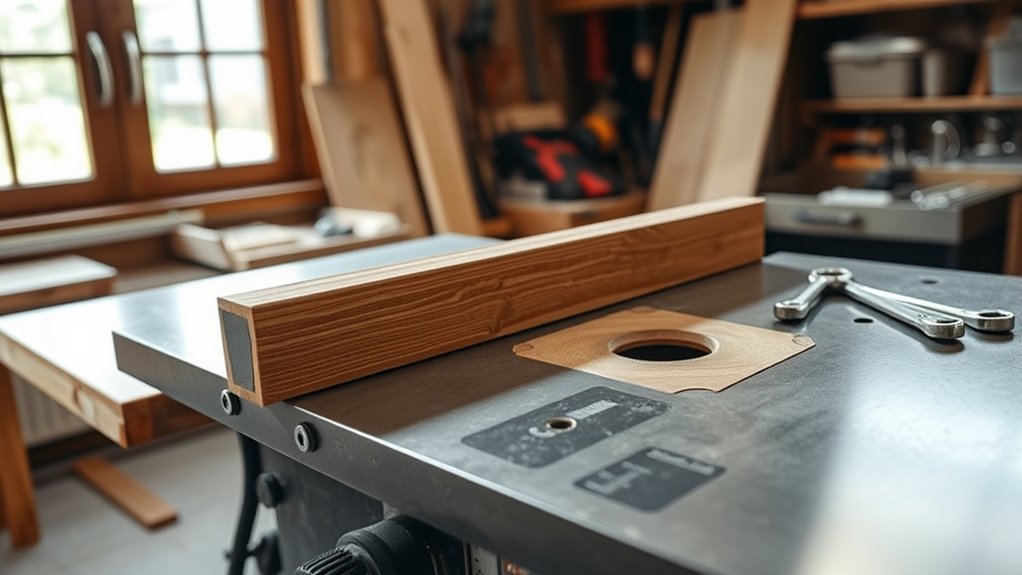
Regular inspections and proper maintenance are essential to keep your woodworking equipment operating safely and efficiently. You should conduct formal inspections at least once a year, especially in high-risk areas like your workshop, and perform ongoing visual checks for early defect detection. Incorporating lifestyle principles such as routine and organization can help you develop a consistent maintenance schedule. Keep detailed records of each inspection, noting faults and corrective actions, and use tailored checklists for different workshop zones. Additionally, staying informed about safety standards can help ensure your practices align with current regulations. Regularly inspecting for wear and tear can prevent unexpected equipment failures that could lead to injuries. Recognizing the importance of preventive maintenance can further extend the lifespan of your tools and reduce downtime. Implementing sound design techniques in your maintenance routines, such as using precise measurements and quality tools, can enhance safety. Daily, clean surfaces and remove debris to prevent buildup. Weekly, thoroughly clean internal components and lubricate moving parts to reduce wear. Regularly inspect and replace worn parts, calibrate settings, and test safety features monthly. Always disconnect power before maintenance, wear protective gear, and follow manufacturer instructions. Establish a maintenance schedule to track tasks, responsibilities, and repairs, ensuring ongoing safety and equipment longevity.
Manage Dust and Respiratory Hazards Effectively
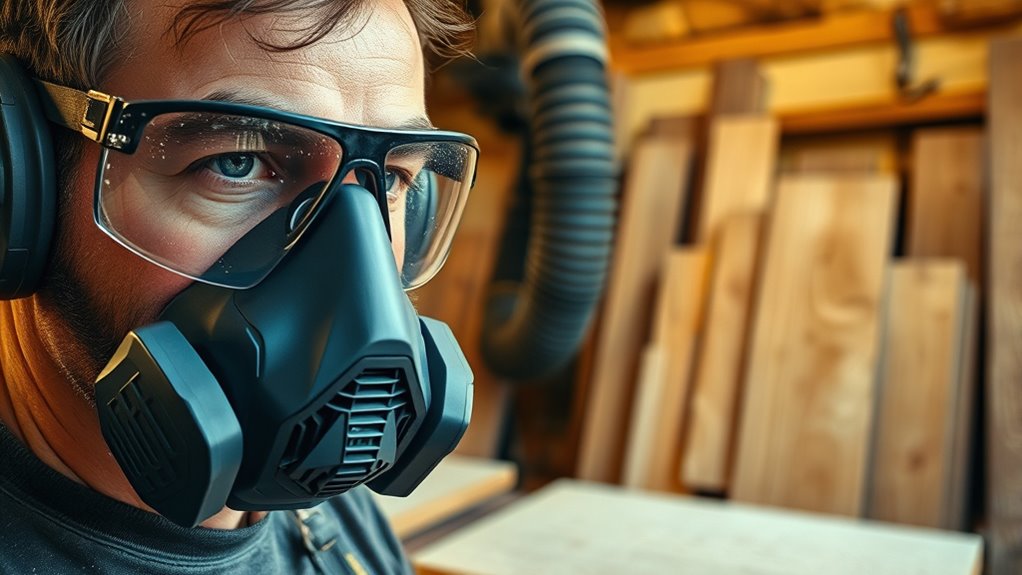
Effective management of dust and respiratory hazards is essential for a safe woodworking environment. You should implement a centralized dust collection system to capture dust across your workshop, and use machinery equipped with efficient local exhaust ventilation (LEV) systems to reduce dust at the source. This not only improves air quality but also complies with safety standards to protect your health.
Attach dust hoods and extraction ports directly to tools, positioning extractors as close as possible to maximize efficiency. Regularly maintain your dust collection systems to prevent blockages and guarantee best performance. Proper general ledger coding ensures financial accuracy] can support the investment in high-quality dust collection equipment.
Wear appropriate respiratory protection, such as masks or respirators, whenever working with or around dust. Employ dust suppression techniques like water-based misting systems and HEPA-filtered vacuums. Quotes highlight the profound impact of proper safety measures on overall health and well-being in woodworking. Implementing AI-driven safety innovations can further enhance your safety protocols by providing real-time hazard detection and alerts, contributing to a more secure workspace. Educate yourself and others on dust hazards, enforce safety protocols, and stay vigilant to minimize inhalation risks and maintain a healthy workspace.
Use Push Sticks, Blocks, and Featherboards Correctly

Using push sticks, blocks, and featherboards correctly is essential for maintaining safety and control during woodworking operations. Push sticks keep your hands away from blades on machines like table saws, reducing the risk of injury. Make sure your push stick is long enough to maintain a safe distance and use proper technique—guiding the workpiece steadily through the cut. Always stand to the side of the blade, apply steady pressure, and wait for the blade to stop before removing the workpiece. Using these tools correctly keeps you safe and in control during your woodworking projects. Additionally, being aware of safety symptoms can help you recognize potential hazards early and prevent accidents.
Be Prepared for Emergencies and Know First-Aid Basics
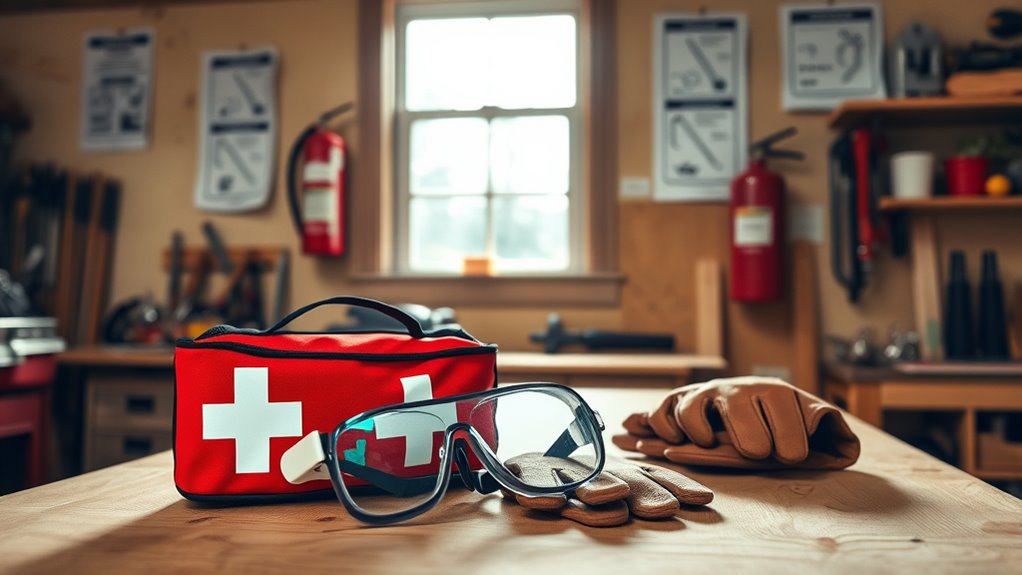
Being prepared for emergencies can make a significant difference when accidents happen in your workshop. Develop and review a detailed emergency plan tailored to woodworking hazards, and train everyone on fire extinguisher use, first aid, and emergency exits.
Being prepared for emergencies ensures swift, effective responses during workshop accidents.
Guarantee family members or coworkers know how to act if you’re incapacitated. Post emergency contact numbers visibly in your workshop for quick access.
Keep a well-stocked first aid kit with items like bandages, antiseptic wipes, burn ointment, eye wash, and finger splints, replacing supplies regularly.
Use dust collection systems, wear eye protection, and inspect tools often to prevent accidents.
Maintain clear exits and keep flammable materials away from heat sources.
Regularly review safety protocols and make certain everyone knows how to respond swiftly during emergencies.
Frequently Asked Questions
How Can I Prevent Kickback on Table Saws?
To prevent kickback on your table saw, always use a riving knife or anti-kickback devices like splitters to keep the wood from lifting.
Keep your rip fence properly aligned, and support the workpiece on both ends.
Use push sticks to guide your cuts, stand to the side of the blade, and avoid twisting the wood.
Regularly inspect your blade for damage, and make certain it’s set correctly to minimize risks.
What Are the Signs of Equipment Wear or Damage?
When it comes to spotting equipment wear or damage, don’t let small issues slip through the cracks. Watch for rust, cracked blades, frayed wiring, or warped parts that can cause trouble down the line.
Listen for grinding or rattling noises, and feel for excessive vibrations or overheating. If you ignore these signs, you’re inviting trouble—better to catch problems early before they turn into costly repairs or safety hazards.
How Should I Select the Right Blade for Each Cut?
When selecting the right blade for each cut, consider the material you’re working with and the type of cut you need. Match the blade size to your saw, and choose teeth count and configuration accordingly—fewer teeth for quick cuts, more for smooth finishes.
Guarantee the blade’s RPM rating matches your saw, and pick a high-quality blade with the right kerf width. Balance your budget with durability and performance for safe, efficient cuts.
When Is the Best Time to Replace or Sharpen Saw Blades?
Think of your saw blade like a vintage record—every cut wears it down over time. You should replace or sharpen your blade when you notice a slower feed rate, rough cuts, increased dust, or vibrations.
If the blade shows cracks or uneven wear, it’s time to act. Regular inspections help you catch these signs early, ensuring smoother cuts and safer operation, much like maintaining a cherished collectible.
How Do I Safely Handle Unexpected Machine Malfunctions?
When you face unexpected machine malfunctions, your priority is safety. Immediately shut off the machine or activate the emergency power shut-off if needed.
Step away and keep others clear until all parts stop moving. Don’t try to force the machine to stop with tools.
Report the issue to your supervisor promptly, and avoid inspecting or repairing until it’s safe.
Always follow proper shutdown procedures to prevent injury or further damage.
Conclusion
By embracing these safety tips, you create a workspace where craftsmanship flourishes and mishaps are gently kept at bay. Think of safety as your silent partner, quietly guiding your hands and helping you avert unnecessary bumps along the way. When you prioritize protection and stay alert, you guarantee every project ends with satisfaction rather than surprises. Remember, a cautious approach keeps your woodworking journey smooth, allowing your skills to shine brightly without any unwelcome interruptions.
